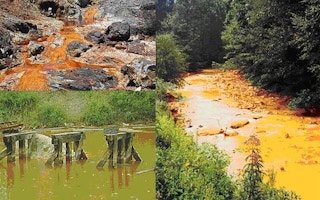Few industries have got the black eye, literally and metaphorically, of mining.
After centuries of environmental effects ranging from toxic emissions to unsightly tailings ponds, acid mine drainage, massive energy consumption and other impacts, mining is slowly cleaning up its act.
Why? Mostly because new clean technologies are increasing industrial efficiencies. They’re lowering mining companies’ power needs. And they’re even helping reduce water requirements, and/or remediating the produced water and mines of years past that are now leaching toxins. And that’s translating into cost savings for mining companies, which are being held increasingly accountable for their environmental impacts and are looking for ways to minimize the expenses of both the production phase of their operations, and reclamation (i.e. the mandated end-of-life cleanup expenses associated with mining in many jurisdictions, now).
In other words, now that it’s starting to be less expensive on net for mining companies to be clean, they’re starting to move in that direction.
Here’s a look at some selected companies at the forefront of new, clean processes in mining today.
New production
Mining project developer American Manganese is preparing to produce electrolytic manganese, used in everything from steel to batteries, from low-grade ore in Arizona.
And it plans to do so at vastly lower costs than the Chinese companies that currently dominate its industry.
How is the company hoping to do so? A lower-power production process intended to use only about six percent of the energy required by the high temperature roasting of conventional electrolytic manganese production. It also plans to produce power onsite from heat exchangers harvesting energy from the production of sulfur dioxide—performed by burning elemental sulfur. And it intends to reduce its water requirements by using precipitation to remove contaminants, with closed-loop water techniques that also involve nanofiltration.
The company also claims its tailings (the output of the process) will be solid and inert, benign enough to be placed right back into the ground with no further processing. No open pool tailing ponds.
Too good to be true? Kachan & Co. just published a report probing the American Manganese process, assessing its potential market impact and what other mining companies might learn from the company.
Toxin remediation and resource recovery
Sister companies BacTech Environmental and REBgold of Toronto, Canada are using a patented biological process to remediate toxins and recover gold, respectively, at a number of sites around the world.
The companies’ BACOX process uses vast amounts of naturally occurring bacteria—which the companies claim are harmless to humans and the environment—in bioreactors to liberate precious and base metals from difficult to treat ores, concentrates and tailings. By providing the bacteria with optimal conditions in closed reactors, BacTech and REBgold say they’re capable of oxidizing sulphides in as little as 5-6 days, as opposed to the many years it normally takes in their natural habitat. The process is also used to free gold and other metals like copper, nickel, zinc, cobalt and molybdenum, according to the company.
The recovery of such valuable materials allows BacTech to offer mine tailing remediation services at no charge to governments, and for REBgold to pursue acquiring and developing economic interests in gold mines, including existing operations in Australia, Tasmania and China.
AMD cleanup
Historically, at the end of production, many mines were abandoned with little environmental consideration. Today, heavy metals remain in tailings piles and in runoff from abandoned mines. Metals such as copper, lead, zinc, and mercury can seep into groundwater. Precipitation percolating through rocks can react with sulfur, forming sulfuric acid and leaching out heavy metals and significantly changing the pH of the water.
Water draining from these tailings piles is referred to as acid mine drainage (AMD). The acidity of the water plus the high metal concentrations can be deadly to animals and plants. Acid mine drainage coats waterways with iron hydroxide, giving impacted bodies of water an orange color.
BioteQ Environmental Technologies of Vancouver, Canada is one of a handful of companies specializing in remediation of AMD. It has built 14 industrial water treatment plants ranging in size up to 25,000 m3/day at mine sites in Canada, the U.S., Mexico, Australia, and China. It uses sulfide precipitation processes for metal removal and recovery, as well as lime treatment.Lime is sometimes criticized for creating solid waste sludge, but it works. Other companies pursue reverse osmosis filtration or other techniques, usually at higher costs and lower rates. Still others attempt to fill in abandoned mines with water, clay slurry or other compounds to eliminate the source of AMD in the first place.
There are scores of new companies forming globally in water treatment, commercially inspired by opportunities associated with the problem of AMD and other mining-related produced water issues. The water-intensive oil sands refining in Northern Canada is also driving important innovation in water technology, as described in a Kachan & Co. report in conjunction with the Artemis Group that introduces corporate executives to the water industry. More details on that report here.
To many, cleantech is still synonymous with renewable energy. But air & environment and clean industry, where clean mining technologies are categorized, remain two important sub-categories of the over-arching cleantech sector. And few industries could benefit from clean technology innovation more than mining. We at Kachan & Co., with offices in Vancouver, Canada—one of the hotbeds of global mining—are encouraged by what we see going on behind the scenes.
After hundreds of years of poor environmental stewardship, and in a world with more watchful eyes than ever, one could argue the mining industry has nowhere to go but up.
A former managing director of the Cleantech Group, Dallas Kachan is now managing partner of Kachan & Co., a cleantech research and advisory firm that does business worldwide from San Francisco, Toronto and Vancouver.
This article was originally published here. Reposted with permission.











